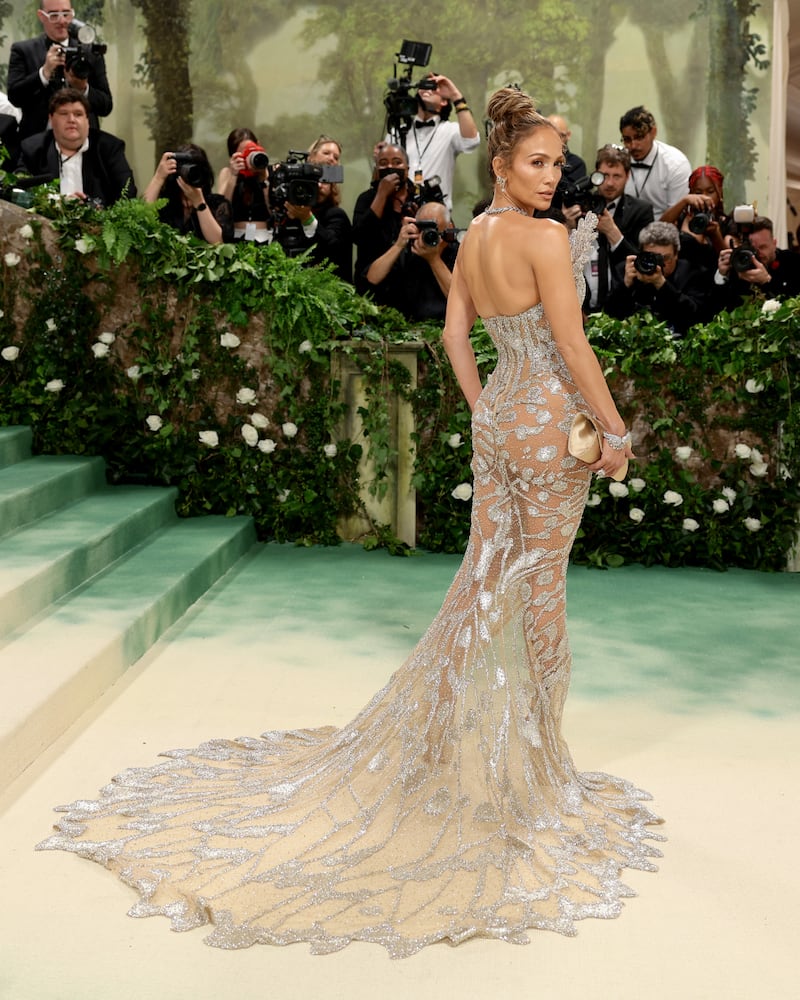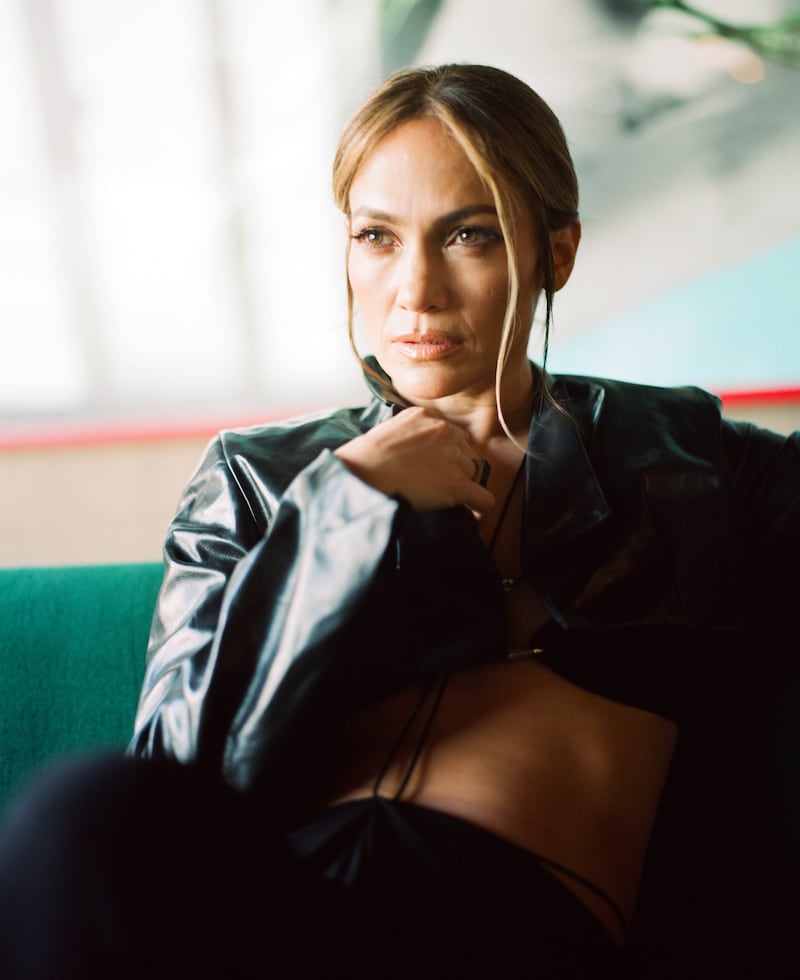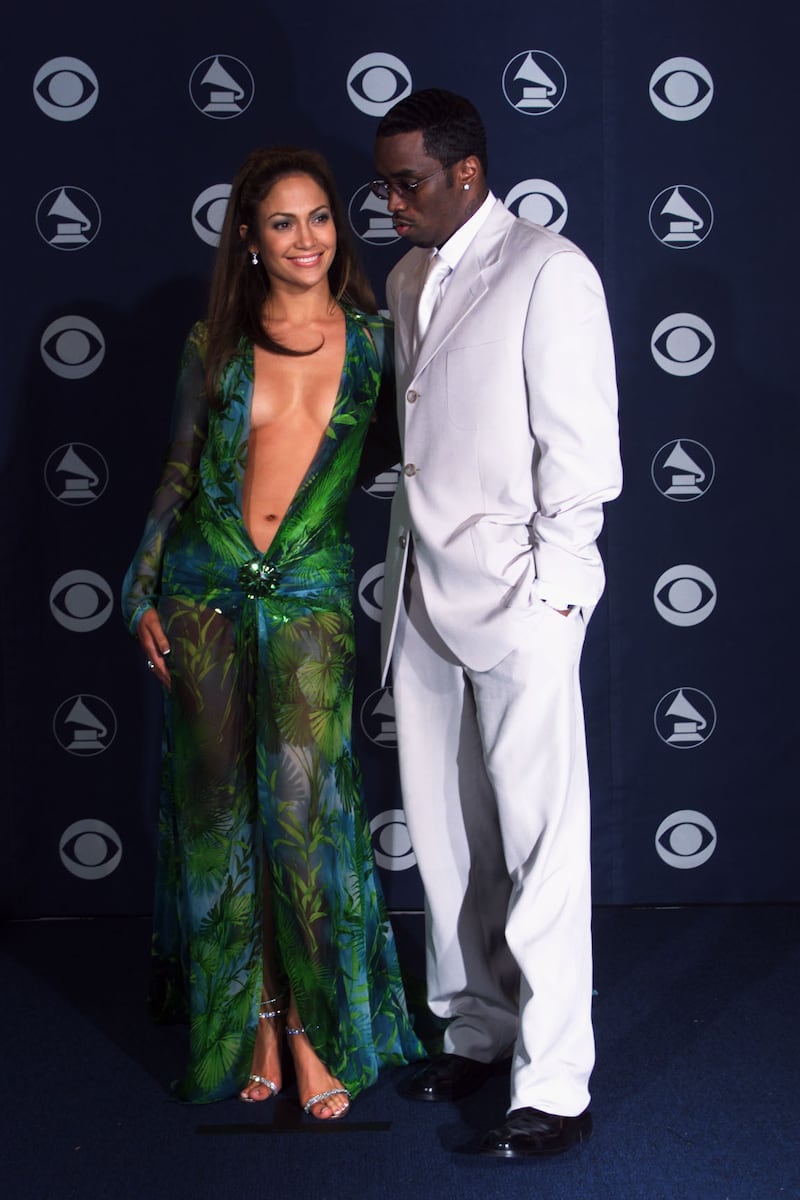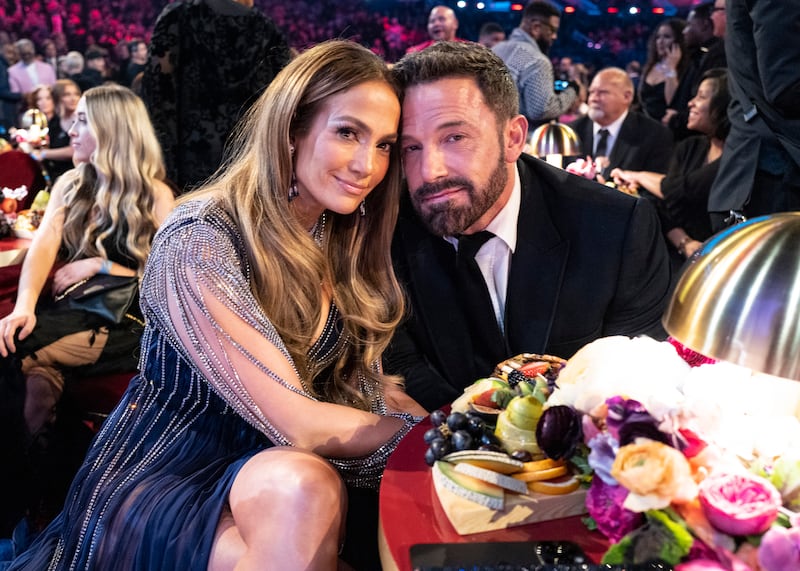An audience with Jennifer Lopez is a model of Fordian efficiency. A small group of journalists is allocated a 10-minute window in the presence of the Latina icon. She’s a busy woman, after all. A triple-threat entertainer with a fortune estimated at up to $400 million, the entrepreneurial star, when she isn’t acting, recording or performing, presides over a fashion imprint, a fragrance that has sprawled into a lifestyle label, a make-up line, a film-production company and a constellation of endorsements and partnerships.
Lopez looks the part. Dressed in slinky nude colours, she is flanked today by Simu Liu and Sterling K Brown, her costars from Atlas, her new sci-fi thriller. The outfit is unadorned yet only marginally less glamorous than the 800-hours-in-the-making Schiaparelli haute-couture gown and Tiffany jewels she wore to the Met Ball. “Her skin is so dewy,” Brown gasps, only half-jokingly.
“You are one of the most beautiful women in the world,” one of the assembled interviewers, who writes for a European men’s magazine, says fawningly. “In the year 2000 you were elected as FHM’s sexiest woman. And we’re now in 2024 and you are still at the top of the most beautiful women. And you’re a role model for so many women. What would your advice for other women be?”
“I appreciate that,” JLo says graciously, as if hearing the compliment for the first time. “That’s very flattering.”
READ MORE
It’s hard to comprehend the intensity of the spotlight she has been under for the past quarter-century. Her Met Gala outfit made headlines around the world. When the Galia Lahav-designed dress she wore in Shotgun Wedding, the Prime Video comedy from 2022, became available at a New York boutique, Bridal Reflections, the place was mobbed.


Her personal life has played out over a series of TMZ-reported exclamation points. With Puffy at the Grammys in that Versace dress! Those red-carpet public displays of affection with Ben Affleck! Welcome, Casper Smart, the age-gap backup dancer! The engagement to the baseball star Alex Rodriguez! And, lest we forget, the high-profile divorce from Marc Anthony, the Latin music sensation who captured JLo’s heart and with whom she shares twins, Max and Emme.
Lopez recently invested a reported $20 million of her own money in two films and an album about finding love with Affleck, who is her fourth husband (and with whom she also, of course, constituted the early-2000s power couple Bennifer).
One of those films, the deliriously wacky This Is Me ... Now: A Love Story, starred Jane Fonda, Sofía Vergara, Neil deGrasse Tyson and Post Malone as celestial bodies observing Lopez’s romantic travails from the heavens. It was conceived as a visual accompaniment to This Is Me ... Now, the album in the trio; the other film, The Greatest Love Story Never Told, documented their making.
Arriving on the heels of Shotgun Wedding and The Mother, This Is Me ... Now: A Love Story was her third film as star and producer in three years. She’s double-jobbing again on an upcoming musical film based on Kiss of the Spider Woman, as well as on Atlas, which is a $100 million futuristic thriller that pitches man (or, rather, woman) against a dystopian artificial-intelligence menace.
People are complex. Sometimes they’re abrasive. Sometimes they are abrasive because of something that has hurt them very terribly. I think it’s important to show that in characters
JLo plays the misanthropic data analyst of the title as she travels to a distant planet in search of a rogue AI revolutionary, Harlan (Simu Liu), whom she has known since childhood. Her disdain for the non-biological is challenged by a mecha-exoskeleton named Smith, who offers assistance when the mission becomes increasingly desperate. It’s an unlikely love story that chimes with the second Bennif-era.
“I loved this script from the first time I read it,” says Lopez. “I loved the fact that it was about AI. It was a big sci-fi action thriller, but the truth at the core of it is a very human story about a woman who is disconnected. I think with technology we have this whole idea that it’s going to connect us, but it really disconnects us.

“This is a very modern story. She’s thrown into this situation with an AI whom she does not trust at all. At the end of the day, the film becomes about her learning to trust someone again, to let somebody into her head and throw her heart at them again. And he wins her little by little.
“I thought that was a very beautiful story. I remember the first time I read the script, I was crying. The way that he was steadfastly there for her. The way he said, ‘I’m not going to leave you. I won’t leave you. I’ll be here. I will take care of you.’ And he did!
“I think that a lot of people can relate to that idea. How difficult it is to trust people. And how they can disappoint you in life. And one person – or one AI – can dismantle that, and show you the consistency you need.”
In recent years some once frowned-upon female archetypes, including the slut (take a bow Samantha, Kim Cattrall’s erotically accommodating character in Sex and the City) and the train wreck (see Phoebe Waller-Bridge’s Fleabag), have been re-evaluated – celebrated – including in Anna Bogutskaya’s book Unlikeable Female Characters. In a commendably unlikeable spirit, Atlas presents as a very prickly action heroine. In Alien, Ripley had a cat to signal a softer side; JLo’s character just has a coffee habit.
“It was funny, there was a lot of debate about that,” says Lopez, “especially in the first cuts of the film. They were, like, ‘Are the audience going to like Atlas?’ And I said, ‘You have to let things develop: you have to trust people.’ I think a lot of actors fall into that trap of being likable. But people are complex. Sometimes they’re abrasive. Sometimes they are abrasive because of something that has hurt them very terribly. I think it’s important to show that in characters. I think a lot of people relate to that.
“I believed in this character. I wanted to go on this ride with her. She has conviction and she wants to save the world. But she comes off crazy because she’s so passionate about it. And because she knows what she’s talking about.”

A movie star must be simultaneously just like us and extraordinary, according to the paradox noted by Richard Dyer, the media theorist whose exquisite studies in movie stardom have framed such golden-age talents as Marlon Brando, Bette Davis, Marlene Dietrich, Marilyn Monroe and John Wayne within the strange interplay between studio control, fandom and manufactured image.
Lopez’s transformation from Jenny from the Block, her early, fly-girl MTV persona, into JLo, the red-carpet queen, fits Dyer’s paradox perfectly.
Her movie stardom was assured after her career-making turn in Out of Sight. She had already scored back-to-back box-office hits with Selena and Anaconda when she won the role of Karen Sisco, a federal marshal who falls for George Clooney’s jailbreaker, in Steven Soderbergh’s 1998 movie.
That role inspired countless bottom-sculpting squat routines and a significant body of academic literature, including a much-quoted paper from 2002 called “The Hollywood Latina Body as Site of Social Struggle: Media Constructions of Stardom and Jennifer Lopez’s ‘Cross-over Butt’”, in which Mary Beltrán, who is now a professor at the University of Texas, provided a keen assessment of JLo’s derrière and early hip-hop tunes.
Lopez, as many critics suggested, should have won an Oscar for her role in Hustlers, the crime caper from 2019 in which, alternately maternal, sisterly, steely and warm, she shone with old-school star wattage. She wasn’t even nominated.
The snub coalesced into a #JusticeForJLo campaign and more fuel for Eric Garcetti, the mayor of Los Angeles at the time, to launch LA Collab, an initiative to support Latino talent in the US entertainment industry.
In 2001, Vanity Fair billed Lopez as the “first Latina superstar”. She was, more accurately, a new kind of Puerto Rican star who, on screen, shifted the narrative away from the Latin lover and firebrand stereotypes that have dominated Hollywood since the pioneering careers of Dolores del Río and Lupe Vélez. As recently as 2011, the Emmy-, Tony- and Oscar-winner Rita Moreno claimed: “I never, ever was able to do a part without assuming some kind of an accent.”
Lopez, by contrast, carved out a movie career in the traditional white preserve of romantic comedies. She was open to blond highlights but wasn’t “whitewashed” in the style of Rita Hayworth (who, born Margarita Carmen Cansino, adopted her mother’s family name) and Raquel Welch (who, born Jo Raquel Tejada, used her first husband’s surname). Those two stars were plucked and bleached at the behest of the Hollywood studios.

You only have to look at JLo’s multiplatform career to see that she has always been a grafter. When she was 18 she worked at a law firm by day and as a dancer in pop videos by night. A backup hoofer for Janet Jackson and New Kids on the Block, she got a TV break as a “fly girl” on the sketch show In Living Color.
Selena, in which she played the murdered Tejano music star Selena Quintanilla-Pérez, earned her $1 million and a Golden Globe nomination. By 1999, two years later, she commanded $9 million a movie. That was also the year she released her debut album, On the 6, which went platinum within two weeks, ultimately selling almost three million copies and gifting the earworm If You Had My Love.
Eight more albums, dozens of movies, a $100 million Las Vegas residency and 252 million Instagram followers later, she says that nothing has changed.
“I think one of the secrets about me is that I don’t ever think I have it really figured out,” she tells our small assembly of journalists. “I never think, ‘I’m great at all of these things.’ I don’t think about that. I just think, ‘How can I evolve? How can I be better? How can I do something different? How can I break more ground and barriers? How do I go where my heart is leading me without fear?’ I say tread forward. Even if you’re afraid.”
Atlas is on Netflix from Friday, May 24th



















